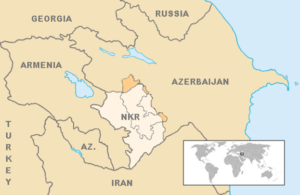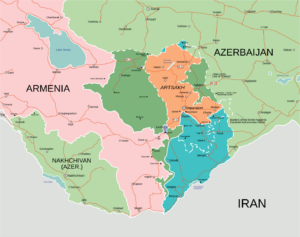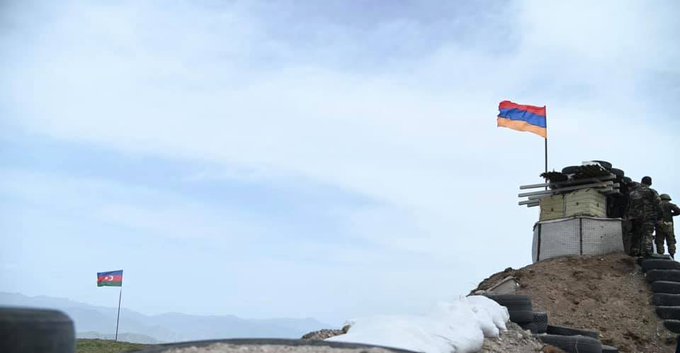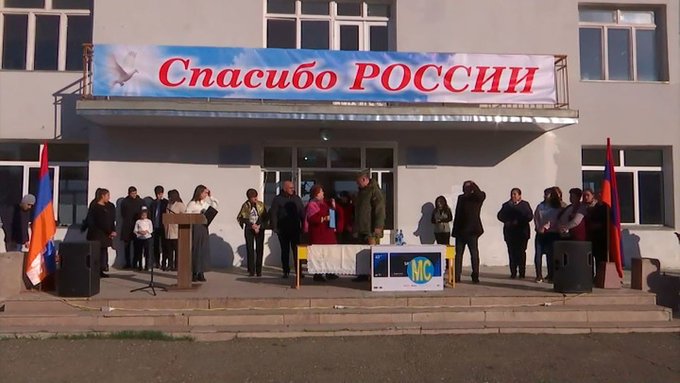Shifts in Territorial Discourse over Southern Armenia
On November 16, 2021, clashes erupted between Armenian and Azerbaijani armed forces near the town of Sisian in southern Armenia, in the province of Siunik. This episode of fighting was notable as the worst altercation since the end of the Second Karabakh War of 2020. The Armenian side reported six soldiers killed and 13 taken captive, with 24 missing, while seven killed and ten wounded was the official count from Azerbaijan. Russian mediation resulted in a halt to the hostilities.
What happened in Siunik – indeed, what has been happening across that border region since May, 2021 – is directly related to the Nagorno-Karabakh conflict. The dispute over Nagorno-Karabakh has numerous complexities. One is the inter-play between claimed borders and effective control. The unrecognised authorities in Stepanakert claimed the territory of the Nagorno-Karabakh Autonomous Oblast (NKAO) of Soviet Azerbaijan, plus the Shahoumyan region to the north. Following the cease-fire in 1994, though deprived of some slivers of NKAO territory in the east and north-east, the Nagorno-Karabakh Republic or Artsakh had at the same time effective control, in whole or in part, over seven additional districts of what used to be Soviet Azerbaijan proper – the areas marked in light beige on the map below outside the lines of the former NKAO.

Image: Nagorno-Karabakh in its entirety of “occupied/liberated territories” (Source: VartanM, Wikimedia Commons)
Thus, over 250 kilometres of what used to be the border between the Armenian and Azerbaijani Soviet republics – stretching from east of Lake Sevan, down to the Arax River on the border with Iran – were never the effective international border between independent Armenia and Azerbaijan. Put another way, there has never been any border regime implemented there – not in Soviet times, not in Romanov times, not since 1991. Now, following the cease-fire of November 9-10, 2020, and the subsequent withdrawals of Armenian forces from the seven districts, the situation on the ground has dramatically changed.

Image: Nagorno-Karabakh after the Second Karabakh War in November 2020. (Source: Kalj/Golden, Wikimedia Commons)
The map above represents the changes. The length of the new effective border marked in dark green and light blue/teal runs down part of the Gegharkounik and Vayots Dzor provinces in eastern Armenia and all of the Siunik province in southern Armenia. Siunik also borders the Azerbaijani exclave of Nakhichevan (Nakhchivan) to the west. The small purple area marked above is the road through Berdzor (Lachin) – the only connection between Armenia and what remains, in principle, of Nagorno-Karabakh under the control of Stepanakert. This road also runs through Siunik.
Russian Forces Pervade the Area
By agreement among the governments of Russia, Azerbaijan, and Armenia (unsurprisingly, without directly involving the authorities of Nagorno-Karabakh), Russian peace-keepers monitor the road leading to Stepanakert, as well as numerous points around the new line of control between Nagorno-Karabakh and Azerbaijan. In addition, by long-standing and new agreements between the governments of Russia and Armenia, deployments of Russian troops monitor the new border in Siunik. Both sets of Russian soldiers often take on the function of mediating disputes.
The mediation is necessary because, since May, 2021, incursions of Azerbaijani forces into Armenia have taken place in Siunik, and also the province of Gegharkounik. Border villages have had mixed experiences, ranging from simply getting used to seeing the Azerbaijani flag fluttering at a military post nearby, to shootings, incidents of shelling, fires breaking out in planted fields, or animals being stolen, sometimes returned, sometimes not. A series of shootings have also taken place in the west, on the Nakhichevan (Nakhchivan)-Armenia border.
Things have not been calm in Nagorno-Karabakh either. According to data from the International Crisis Group, as of February 15, 2022, 125 Armenian and Azerbaijani soldiers as well as 95 civilians from both sides have been killed or wounded since the end of the Second Karabakh War. Numerous incidents of shooting and landmines causing deaths have been recorded alongside other tense episodes. For example, the village of Khramort has experienced both shelling as well as the use of loudspeakers by Azerbaijani forces to discourage Armenian farmers from working patches of land on the new line of control. A Russian peace-keeping unit has set up a new position there and has used loudspeakers of its own as a counter-measure.
Transformed Conflict
The expression “the end of the Second Karabakh War” may be very misleading indeed. At the very least, it does not do justice to the nuanced developments in the seventeen months since November 9-10, 2020. The conflict has transformed, gaining new dimensions. The immediate presence and involvement of Russian armed forces has been one major addition. Besides the trilateral and bilateral arrangements mentioned above, Russian troops also serve alongside Turkish counterparts in a joint cease-fire monitoring facility east of Nagorno-Karabakh. There is also a significant increase in the involvement of Iran, directly or indirectly, in the region, particularly when it comes to the developments in Siunik.
Another change has involved a shift in discourse. Before the 2020 war, the Nagorno-Karabakh issue was framed around the question of status, as an intractable conflict between the principles in public international law of national self-determination and territorial integrity. Now, although this element remains, developments along the new border have created new priorities. There is a sense of urgency, especially in Yerevan, where the government led by Nikol Pashinyan has, in all events, been more reticent in speaking up about the status issue or other priorities for Stepanakert.
As prominent journalist and analyst Tatoul Hakobyan notes, the foreign policy priorities for the government of Armenia are three-fold at present: regulating the border with Azerbaijan, establishing regional transportation routes, and normalising relations with Turkey. That second point stems directly from the outcome of the war of 2020 and has an immediate impact in particular on the province of Siunik.
“Zangezour Corridor”
Coupled with the incidents since May, 2021, the government of Azerbaijan has been increasing pushing its foreign policy priorities and its vision for the region. The “Zangezour Corridor” (or “Zangezur Corridor”) has been particularly emphasised by the leadership in Baku. All throughout the Nagorno-Karabakh dispute, the prospects of a direct link between Azerbaijan proper and the exclave of Nakhichevan (Nakhchivan) featured as a possible component of any long-term resolution arrangement. Any such geographical link north of the Arax River (i.e., ruling out Iranian territory) would have to go through Armenia, through Siunik.
In Armenian, Zangezour is an alternative name for Siunik – itself a re-application of the name of an ancient Armenian province (nahang) which, very roughly, overlaps with the territory of the current province (marz) of Siunik. (Likewise, “Artsakh” was the designation of such a nahang in ancient times, overlapping with Nagorno-Karabakh.) This administrative division of the Republic of Armenia came into being in 1995 with the consolidation of the Soviet-era regions (shrjan) of Sisian, Goris, Kapan, and Meghri. The terms “Siunik” and “Zangezour” are used interchangeably in Armenia. (I conducted fieldwork in Kapan and Goris in the autumn of 2021. An overwhelming majority of my interviewees identified Zangezour and Siunik as one and the same. It was only among the younger interlocutors that a preference for “Siunik” outweighed “Zangezour”, although even this phenomenon was not consistent.)
In Azerbaijani nationalist discourse, Zangezour (Zangezur) is considered to be historical Azerbaijani territory. Although the appellation is surely older, the name and more specific geographical territorial imagination of Zangezour probably stems from 1868, when the Zangezour district (uezd) of the Romanov Empire was created. It included most of what is the Siunik province today, plus certain areas to the east, namely some of the seven districts formerly under the effective control of Nagorno-Karabakh. Though not quite exactly the same, “Siunik” and “Zangezour” are used interchangeably for rhetorical purposes in Azerbaijan as well. In fact, nationalist geographical imaginations having found new instrumentalisation in that country since 2020. The proclamation by President Aliyev naming an “Eastern Zangezur” economic region on July 7, 2021, was met with contempt and alarm in the Armenian leadership and media. If there is an Eastern Zangezour, there is also a Western Zangezour – Siunik.
To give another example, when the head of the National Defence Management Centre of the Russian Federation mentioned during a press conference in early March, 2022, that humanitarian aid had been sent to Ukraine from Nagorno-Karabakh, the Azerbaijani defence ministry reacted with strong criticism on the use of the term. The position that “the words ‘Nagorno-Karabakh’ should not be used anymore” and that there is no such entity have been a consistent talking point pushed forward by Baku over the past year and a half. The Azerbaijani government is insistent on changing geographical territorial imaginations and is sensitive to discourse which counters its framings.
The fact remains that both Baku and Yerevan – with due participation from Moscow – officially agree to establish roadways and railways which will allow for the movement of goods and people from Armenia to Azerbaijan, through Nakhichevan (Nakhchivan), in principle connecting with Russia as well. The concept of the “Zangezour Corridor” as used by the leadership in Baku is meant to mirror the corridor through Berdzor (Lachin) – the road connecting Stepanakert with Armenia. This road is not under direct Azerbaijani control, being overseen by Russian peace-keepers. There are no customs check-points along the way. Although the exact formulation of “corridor” is not clear, and nor is it, say, a well-defined concept in public international law, the demand from the Azerbaijani government hints at some sort of free and unhindered link to Nakhichevan (Nakhchivan), in principle connecting with Turkey as well.
At the same time, alongside statements on agreements, there has long been a pattern of flare-ups of violence in the run-up to negotiations between Azerbaijani and Armenian leaders. The particularly heavy round of fighting of November 16 took place ten days before Pashinyan and Aliyev met in Sochi. The clash occurred near the narrowest point of Siunik which could lead to a road into Nakhichevan (Nakhchivan), but any future transportation connection is more often expected to run through the Meghri region at the very south, following the Arax River valley on the border with Iran. The topography is more suitable there, being flat. Road and rail infrastructure existed through Meghri even before the Soviet era.
Codifying a New Status Quo
The panic and urgency caused by incidents of violence or incursions shifts the attention away from the issues of territory and status for Nagorno-Karabakh, offering alternative or additional framings for negotiations. In this context, codifying the position that Nagorno-Karabakh no longer exists as such is a priority for Baku.
The latest development on that front as of this writing came on March 14, 2022. The Azerbaijani government presented a list of five demands to the government of Armenia as a basis for a peace treaty and establishing future relations. It pulls back somewhat from the rhetoric and the actions of the preceding months, insisting on normal relations and communications, as well as no territorial claims – from either side. It makes clear demands on recognising territorial integrity in perpetuity. Such a demand would, as former president Robert Kocharyan expressed it, draw a line over Nagorno-Karabakh, crossing it out forever. The pattern of creating tense situations on the ground before negotiations has been repeating this time as well, especially in Nagorno-Karabakh. Apart from the incidents around the village of Khramort mentioned above, other settlements have also been targeted. In addition, the only pipeline providing natural gas to Nagorno-Karabakh has been damaged, with Azerbaijani forces preventing its repair for over a week even as temperatures remain low in the area.
The government of Armenia has had to navigate between bad and worse foreign policy options since the end of the Second Karabakh War. It has appealed to the Minsk Group – the long-standing mediators in the Nagorno-Karabakh conflict, led by the governments of the United States, France, and Russia – to mediate more generally between Yerevan and Baku. Broader global dynamics, most notably the conflict in Ukraine, will surely also play a role in shaping relations between Armenia and Azerbaijan, determining the future of Nagorno-Karabakh and the Armenian population there, and also Siunik.
Author: Nareg Seferian






